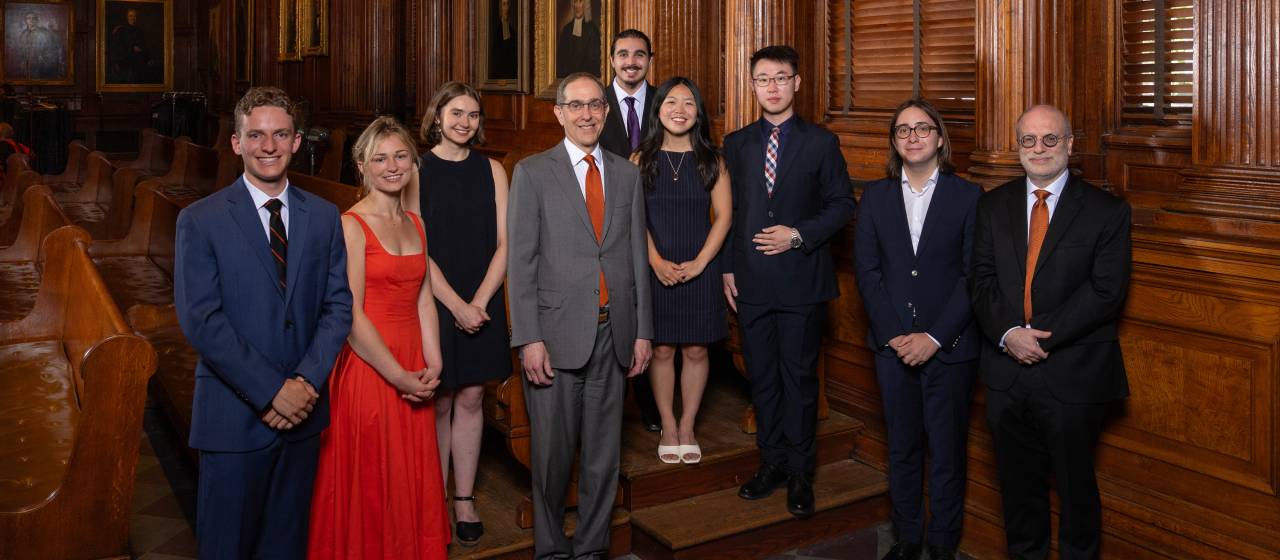Senior Thesis Spotlight: What isotopes in redwood leaves reveal about dinosaur diets
You wouldn’t think that one of the world’s tallest trees would be easy to hide. But when Rio Baran of Princeton’s Class of 2025 set out to study a 350-foot California redwood, she was sworn to secrecy about its location in a hidden ravine.
Guided on a scramble down a steep slope by a botanist who had studied the massive redwood — and who urged her to somehow not step on any plants as they descended — Baran arrived at the tree breathless in more ways than one.
She had come to collect soil, water and plants — iris, sorrel, maple, tanoak, bracken fern, swordfern, as well as tiny bits of bark and leaves from the enormous tree — which she planned to measure for calcium and magnesium isotopes.
Her senior thesis research sought to explore what few scientists have attempted: using the isotopic analysis of modern plants to better understand the habitats and diets of long-extinct dinosaurs.
But for Baran, this research in the redwoods not only would help answer questions about isotope exchange and paleoclimatology. It would also shift her concept of the interconnectedness of earthlings across time.
“Standing under that tree,” she would later recall, “changed the way I understand plants and my relationship to them.”
Explorations in geoscience
“Rio is an exceptional undergraduate student,” said her adviser, geosciences professor John Higgins. “She’s very committed to all kinds of geosciences, from rocks to trees and oceans and everything in between.”
In addition to piecing together the dinosaur diets through isotopes collected in and near the giant redwood, she has done fieldwork on fossils in the Australian outback to understand the role that sponge-like 600-million-year-old creatures might have played in the Cambrian explosion.
For junior year independent work, she learned how the eggshells of enormous, extinct elephant-birds allow scientists to better understand the history and coexistence of past animals and people.
Under the midnight sun and midsummer snow of the Alaskan Arctic, she plotted how changing plants signal a changing climate.
“Rio is somebody who, under any circumstances — rain or shine or snow, late nights or early mornings — is always excited by the process of learning,” Higgins said. “That makes teaching better. I get to learn alongside her.”
Support from Princeton’s High Meadows Environmental Institute and Office of Undergraduate Research allowed her to pursue fieldwork as an undergraduate researcher.

In addition to piecing together the dinosaur diets through isotopes collected in and near a giant redwood, Baran has done fieldwork on fossils in the Australian outback, studied the eggshells of extinct elephant-birds and worked with plants in the Alaskan Arctic to understand climate change. “Rio is somebody who, under any circumstances — rain or shine or snow, late nights or early mornings — is always excited by the process of learning,” Higgins said.
Isotopes, dinosaurs, and the redwood in the ravine
Isotopes are forms of an element that vary ever so slightly in their number of neutrons, leaving what you might call chemical fingerprints. Scientists can track them to plot how elements move within ecosystems — from oceans up into clouds, through raindrops soaking down into soils, up roots and trunks, out branches to leaves, and into the animals that eat them.
Baran knew that by comparing isotopes — in different plant species, in plants growing in different places, in different plant parts, and at different heights within the same plant — we can better understand how nutrients cycle within ecosystems. And she knew that this knowledge is a way to better understand dinosaurs.
Because, as it turns out, isotopes within tooth enamel carry chemical clues that can last for millions of years.
Equipped with new technology, scientists have begun noting tiny chemical differences in the fossilized teeth of dinosaurs that might indicate that they ate fruit, or leaves, or fish, or other dinosaurs.
This information can help answer paleoecological questions like: What was their larger food web? And how could a single ecosystem support so many large herbivores at once?
For her senior thesis, Baran set out to advance this knowledge in what would become the first published study of magnesium and calcium isotopes together.
She wanted to investigate them across different sites, species, plant parts, and particularly at various heights within a single tree. And for a researcher looking to learn how these chemicals change as they move up from soil skyward, what better plant to study than one of the tallest in the world?
All of which brought Baran to the California forest, an ecosystem not unlike those from the time of triceratops. After all, redwoods as a species are nearly as old as the first dinosaurs, dating back 240 million years, while ferns are found in the fossil record over 380 million years ago. What might these plants tell her about the past?
Baran reached out to plant biologist Zane Moore about his genomic study of one very tall, 1,400-year-old redwood and he agreed to take her to it last summer. There, and at another site closer to the coast, she carefully collected samples of plants, water and soil that she would spend the next year studying at Princeton.
A grinding senior year in the lab
Back on campus, she painstakingly dried the samples on hot plates and in ovens, ground them into powders, digested them in acid and analyzed them with a state-of-the-art mass spectrometer.
Baran started grinding this past September as her senior year began and worked in the lab for hours each day, seven days a week, straight through March. She produced her first isotope data around spring break.
“What they don’t tell you about getting calcium and magnesium data,” she laughs, “it’s really hard to do!”
After months of monitoring samples on cutting-edge machines in the basement of Guyot Hall, Baran finally obtained her isotope data, and began analyzing the findings alongside data sets from dinosaur teeth. The comparison led her to questions about the relationship between different isotope systems.
Are magnesium and calcium isotope signals correlated across plants? Within plants? Might potassium mediate nutrient transport through plants and thus play a role in calcium and magnesium isotope signals?
Questions, answers and more questions
“Academic research is ultimately driven by creativity and curiosity,” Higgins said. “What made Baran’s thesis exceptional is that she was able to ask questions and have access to scientific and technical tools to answer them. And then ask another set of questions and then try to answer those questions. … That iterative process of discovery is at the heart of what research is.”
Her results coalesced this spring. The data did reveal differences, such as higher calcium isotopes in tanoak and redwoods than in ferns, iris or sorrel.
But Baran's most promising contribution isn’t just her novel analysis of calcium and magnesium, but her larger conclusion that examining these two isotopes together draws out data clusters that better characterize variation in plants — and, when compared to isotopes in teeth, lead to more conclusive hypotheses about diets and ecologies.
Impact across species and eons
Scientists can apply this process to the teeth of any animal, extinct or extant, to unlock clues about where it lived and what it ate.
Baran's work also offers applications for the present, and the future. As we learn more about how these elements move through environments — from water to soil to plants and on — we can better understand nutrient deficiencies in agriculture and agroforestry, and thus better manage farming and soil practices.
Ultimately, these findings have the potential to inform scientists’ understanding of the carbon cycle and other planetary feedback loops that keep our atmosphere habitable.
Her thesis measured very small differences in the weight of very small particles, mostly from one very tall tree, and connected the dots to creatures that went extinct millions of years ago.
In a pensive appendix, she wrote: “Across space, across time, across species, we are all tied together by the movement of isotopes.”

Baran's research in the redwoods gave her a new sense of interconnectedness. “Across space, across time, across species, we are all tied together by the movement of isotopes,” she wrote in a pensive appendix to her thesis.
















